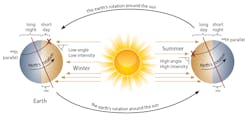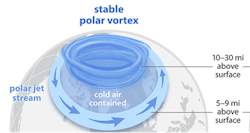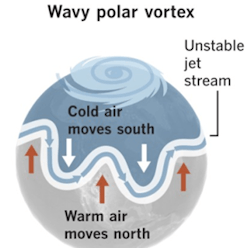Q: Can global warming cause cooling?
Can the use of the laws of process control help to explain why global warming can cause cooling? Is the size of polar vortex events increased by global warming? Do dead times, time constants, capacitance or feedback effects play a role here?
Z. Friedmann
Instrument Engineer
[email protected]
A: I should start by saying that on the one hand I am not a weather scientist, but a process control engineer. On the other hand, I am used to analyzing the behavior of complex processes, and the weather is one of those. The most basic rule of process control is that we must fully understand the process in question. In case of the polar vortex, we have to analyze the combined effects of the following processes:
- The effects of Earth's rotation around a tiled axis and the albedo effect
- The travel of heat and the directions of the winds on the global surface
- The Coriolis effect
The effects of Earth's rotation around a tilted axis and the albedo effect: If we look at it from the north pole, Earth rotates counter clockwise (east to west) and if it was not warmed by the sun, gravity would hold the atmosphere to the planet's surface and it would travel with it. There would be no winds. Because the atmosphere is heated by the sun, the insolated regions’ warm water evaporate, which makes the air even lighter, and there the light air lifts. In the areas that do not receive solar energy, the is colder (heavier air) moves in below the warm air and winds evolve. The direction of the winds vary, because the air always moves to the areas where low pressures develop, which most often are the warmer locations or regions.
1. In the tropical zone (between the Equator and 30° latitude), the trade winds are coming from the northeast dominate as they move heat towards the north.
2. In the mid-altitude zone (between 30° and 60° latitudes) the dominant winds that carry the heat further north are blowing from the west.
3. In the polar zone (between 60° latitude and the north pole) easternly winds carry the heat towards the north pole.
The Coriolis effect: If there was no Coriolis effect, the air would rise at the equator, move to the north pole and sink there. The Coriolis effect is caused by the rotation and the global shape of Earth. This is because as the air moves towards the poles, the diameter of the globe drops and therefore a point on its surface moves (rotates) slower and slower as it moves towards the poles. At the equator a point on Earth's surface rotates at 1,000 miles per hour (1,600 km/h), while at the north (or south) pole at zero. Therefore, the counter-clockwise rotation of the colder air on the northern hemisphere, while moving towards the equator, is picking up speed as if it was moving downhill while the rotational speed of the warm air that is moving north was slowing down, like moving uphill. As the cold air circulates faster as it moves to the south, it is deflected to the left (west) and as the warm air above it moves to the north, its path is deflected to the right (east). It is for this reason that in the tropical zone, (also called the Headley cell, which is between the equator and latitude 30°north in Figure 2), the "trade" winds blow from the northeast and at around 30°N, where the mid-latitude starts, the hot air from the equator cools, descends back toward the ground and moves back toward the equator, while the heat is transported forward north by the westerly wind in the mid-latitude, as it moves towards the polar latitude starting at 60°N.
Béla Lipták
liptakbela@aol.com
About the Author
Béla Lipták
Columnist and Control Consultant
Béla Lipták is an automation and safety consultant and editor of the Instrument and Automation Engineers’ Handbook (IAEH).

Leaders relevant to this article:




